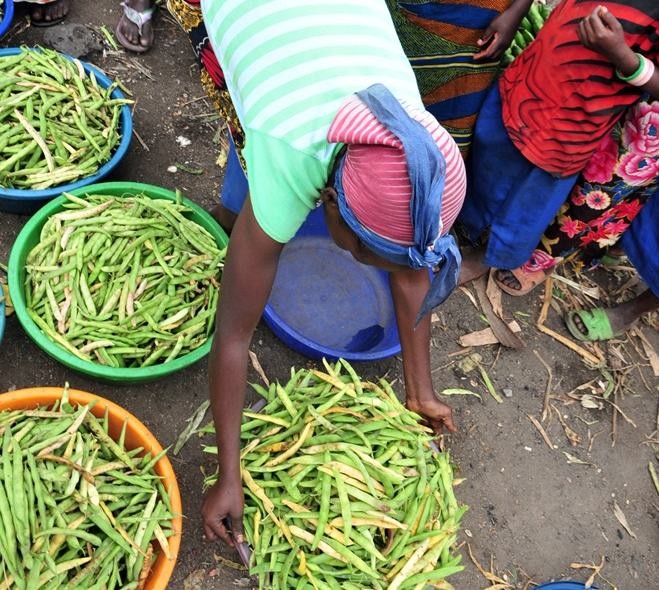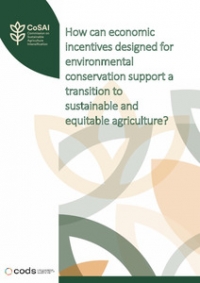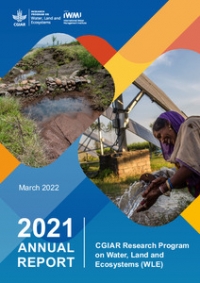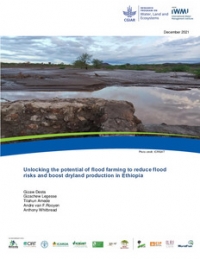Will 2013 be pinpointed as the year in which Africa’s ‘Green Revolution’ finally took root? It marks the tenth anniversaries of the 2003 Maputo Declaration and the resulting Africa-led Comprehensive Africa Agriculture Development Programme (CAADP)—which aim to reverse decades of underinvestment in agriculture and eliminate hunger and poverty through agriculture, respectively. It also marks 50 years of the African Union.
 Bean market in the North Kivu Province of Democratic Republic of Congo. Photo Credit: Neil Palmer/CIAT
Bean market in the North Kivu Province of Democratic Republic of Congo. Photo Credit: Neil Palmer/CIATAt this pivotal time, grassroots advocacy and campaigning organization ONE has set out to quantify progress made by African governments towards meeting the specific Maputo pledges, which include allocating 10% of budgets towards agriculture and seeking 6% annual agricultural growth by 2008. In its report A Growing Opportunity: Measuring Investments in African Agriculture, it seeks to hold governments and donors accountable to their past commitments on agriculture, as well as make recommendations for accelerating change in future.
“African governments have an excellent opportunity to transform the agricultural sector, while ensuring the rights of farmers and minimizing impacts associated with large-scale farming interventions,” says Michael Victor, Communications Coordinator of the CGIAR Research Program on Water, Land and Ecosystems (WLE).
By January 2013, 24 of the 55 states on the African continent had signed CAADP ‘compacts’, held business meetings and launched solid, costed and technically reviewed investment plans to accelerate agricultural development. The ONE report examines 19 countries that went through this process.
The good news is that 13 countries (of 15 with available data) have achieved the targeted annual agricultural growth of 6% or more. But, when set against the agricultural potential of Africa the report reveals a stark message that there is much room for improvement; under favourable circumstances, Africa could feed its own people as well as supplying food to other parts of the world.
Investing in small-scale agriculture
Investing in smallholder farmers, in particular, could reduce poverty and yield more food. A recent IWMI-led study found that investments in motorized pumps, enabling farmers to better irrigate their crops, could benefit 185 million people in sub-Saharan Africa and generate net revenues up to USD 22 billion per year. This is equivalent to the amount pledged by donors at the 2009 G8 summit to help African governments fulfill their agricultural development aims.
Modernizing the agricultural sector will require significant investment but this will be vital if Africa is to realize its agricultural potential. The CGIAR is working closely with CAADP to support agricultural transformation across the continent through agricultural research, extension and education. CGIAR research for development programs such as WLE are committed to sustainable modernization within the context of ensuring that the majority of African farmers, who are women and smallholders, get a fair share.
Investment is key to reducing poverty. Fifteen of the 19 countries studied failed to increase investment in agriculture to 10%, leaving a USD 4.4 billion shortfall in funding. Yet Niger and Ethiopia, two of the four countries that did meet the investment target, are on track to halving extreme poverty by 2015.
Funding shortfalls are not exclusively from African governments. While donors have legally obligated their financial pledges, only half of their financial commitments have been disbursed. This perhaps stems from the report’s finding that half of the countries had major flaws or gaps in their budget documents. The investment planning process needs to be more transparent. And governments must re-consider how they involve a wider group of non-state actors as they develop their national agricultural plans.
Most of the national agriculture investment plans lack a clear focus on women farmers. Correcting gender inequalities alone could make a big difference to yields. In sub-Saharan Africa, female farmers contribute 50% of labour on farms but only own 1% of land. They do not have the same access to credit or inputs, such as fertilizer and pesticides, as men. According to the Montpellier panel of agricultural experts, women could raise the yields on their farms by between 20% and 30% just by having the same access to, and control over, resources as their male counterparts. If this were to happen across the developing world, the increase in agricultural output could cut the number of hungry people by 100 million.
Managing resources sustainably
While the ONE report focuses heavily on investments, government involvement, women and nutrition, we must not forget the importance of social and environmental impacts from increased and intensified farming activities. The original CAADP vision outlined in 2003 included goals to “practice environmentally sound production methods and have a culture of sustainable management of the natural resource base.” Appropriate land and soil management, as well as improved access to water by farmers, will be critical to ensuring the sustainability of agricultural programs. National agricultural plans should take into account environmental management and sustainability in tandem with ensuring the rights of farmers.
In a couple of months, leaders from the developed world will gather in Northern Ireland for the 39th G8 Summit. This will provide an opportunity for the international community to reinforce the CAADP by filling the funding gaps in national agriculture investment plans. Meanwhile, the commitment period of the Millennium Development Goals is still two and a half years away, providing African nations with a chance to get their Maputo commitments back on track. But as 2013 gives way to the 2014 Year of Agriculture in Africa, will there be a united effort to create the conditions in which Africa’s farmers can flourish, its nations become food secure and poverty is consigned to the history books?























Comments
It is being rather too ambitious to think that cultural barriers that inhibit equal distribution of land between males and females in Sub-Saharan Africa can be overcome anytime soon. Even if that was achieved, it is doubtful that women would be able work the land much more than they do, through their 50% contribution to labour. My view is that their contribution would remain the same except they would be working their own fields, a scenario that would not change total food production and enterprise productivity.
Given the above thinking, I do not think that the foregoing would ever be true, "In sub-Saharan Africa, female farmers contribute 50% of labour on farms but only own 1% of land. They do not have the same access to credit or inputs, such as fertilizer and pesticides, as men. According to the Montpellier panel of agricultural experts, women could raise the yields on their farms by between 20% and 30% just by having the same access to, and control over, resources as their male counterparts. If this were to happen across the developing world, the increase in agricultural output could cut the number of hungry people by 100 million."
After 35+ years in Africa as a farming systems agronomist, Africa's green revolution in my opinion will depend on massive multiplication and use of NERICA rice varieties in SSA.